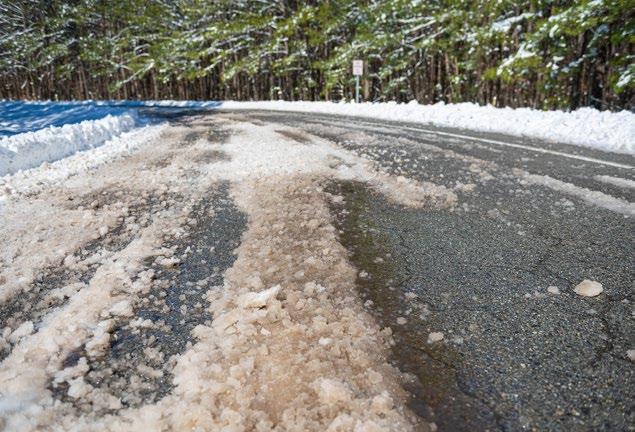
2 minute read
A r DOT Strike Team: PREPARED FOR WINTER WEATHER
BY DAVID NILLES
OH, THE WEATHER OUTSIDE IS FRIGHTFUL," SO SAYS THE POPULAR HOLIDAY SONG. And indeed, it can be just that when ice and snow begin to accumulate on highways across the Natural State.
Long before the frozen precipitation begins to fall, you can rest assured that ArDOT’s District Maintenance crews are hard at work. They are the front line of defense, preparing the trucks with spreaders and plows, loading up with salt and sand, and driving targeted highway routes within their Districts clearing the roads of winter precipitation.
But that is just the beginning of ArDOT’s efforts when it comes to battling frozen precipitation.
In addition to the District Maintenance crews, ArDOT now has a Winter Weather Strike Team standing by in central Arkansas waiting to spring into action where needed.
In fact, the more than 90 field personnel from the statewide striping, signing, milling and heavy bridge maintenance crews that make up the Strike Teams began conducting drills in early December, so they are ready when snow and ice arrive.
The Winter Weather Strike Team differs from District crews in that, as opposed to clearing a specific multi-county area, the team travels to areas across the state that need the most attention, no matter what part of the state that may be. The teams will receive a request from
District Engineers as the need arises and hit the road to assist those Districts as requested. They may be in central Arkansas one day and in southeast Arkansas the next following a storm as it moves across the state.
Each strike team is comprised of one multi-axle dump truck outfitted with a plow and salt spreaders, drivers, supervisors and a mechanic. Strike teams are supported by Equipment & Procurement maintenance trucks, mechanics and Districts where applicable.
“It is crucial that we do everything we can do to be prepared when winter weather hits,” explained Michael Kelly, ArDOT Staff Maintenance Engineer and
(continued on page 6)
Emergency Management Liaison Officer. “These drills help us see both our strengths and areas for improvement. It is our job to keep our roadways safe, and we take that responsibility seriously.”
The challenge of clearing the highways begins before the trucks ever leave the ArDOT campus. Crews must check their equipment to ensure it is in good working order, test communication capabilities, know what to do if there is an emergency and make sure to have flashlights, batteries, ice scrapers, flares, blankets, extra parts and tools on hand. Food and drink must also be considered when out on the icy roadways because like maintenance crews, the Winter Weather Strike teams battle the weather 24 hours a day.
The drills held in December began in the Emergency Operations Center
(EOC) housed in the Maintenance Division building at Central Office. It is here that coordinators assessed a winter weather scenario and devised a plan of action for the highways affected including Interstates 30, 40, 430, 440, 630 and Highway 67. That plan involved prioritizing what highways to clear, assigning teams to those highways and planning work shifts for team members. Then it was time for crews to hit the road.
Once on the highways, personnel in the EOC can easily communicate with their teams and also track their location using a wall of video monitors.
“I think the drill went very well,” stated Michael Kelly, Staff Maintenance Engineer and Emergency Management Liaison Officer. “We identified some strengths and areas for improvement that will now make us an even better team moving forward.”








